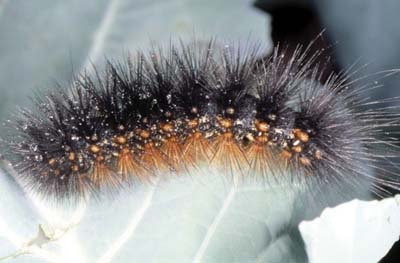
Saltmarsh caterpillar, Estigmene acrea, larva on broccoli.
Larval appearance varies considerably, but the hairs are
quite long in the older caterpillars.
(Photographer: L. Buss, University of Florida)
The saltmarsh caterpillar has a wide host range including many vegetable crops as well as many weeds. The favored weed host is pigweed (Amaranthus spp.). The saltmarsh caterpillar tends to defoliate plants and is usually a problem later in the growing season, closer to fall. Parasitoids occur naturally but insecticides are usually applied to manage the population. Damage is usually first noticed at the edges of a field, so trap crops may be an effective tool to control the saltmarsh caterpillar.
Images
To save the Web-optimized images shown below to your hard drive:
|
Click to access Display and Print quality images. |
|
Click to access Display and Print quality images. |
|
Click to access Display and Print quality images. |
|
Click to access Display and Print quality images. |